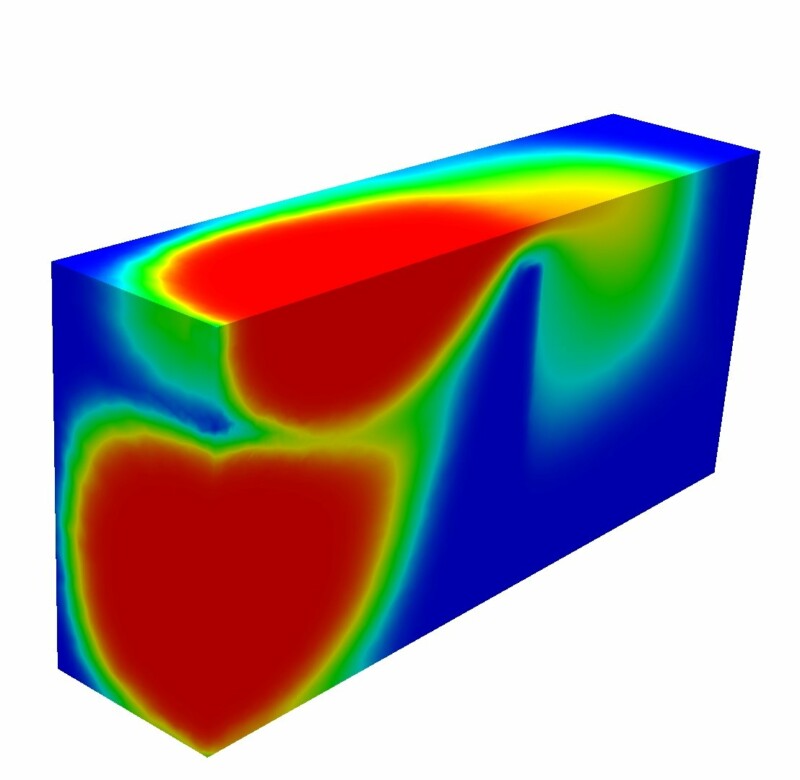Richy 2D/3D
Software Richy2D/3D

The Software Richy2D/3D solves reactive transport problems in two or three spatial dimensions. The system consists of PDEs for the concentrations of the mobile species and ODEs for the concentrations of immobile species. Reactions can be kinetic and/or equilibrium. If equilibrium reactions are involved, algebraic equations are coupled to the PDE-ODE-system. The groundwater flow can either be given or be computed through the Richards equation.
The software is programmed using M++. It is running on parallel computers. The definition of the scenario and the choice of numerical parameters/algorithms is done by a script-file; a graphical user interface is not available.
Richy2D/3D is based on the global implicit approach (one step method). Its development is driven by the intention to apply modern mathematical techniques to geoscientific problems. Richy2D/3D uses a specific model-preserving size reduction technique to reduce the required cpu time. Reactions with minerals are expressed as Complementarity Problems (CPs) and solved by the Semismooth Newton method. For details on the size reduction technique see the following literature. For the CPs and Semismooth Newton see the habilitation thesis and the AWR publication in particular. The software and its solution algorithms have been awarded in an international benchmark study for reactive multicomponent transport codes (MoMaS) as the most innovative work giving very accurate results while significantly reducing computation times (see also the Comput. Geosc. publications).
- Hoffmann, J., Kräutle, S., Knabner, P.: A general reduction scheme for reactive transport in porous media, Comput. Geosci., 16, p.1081-1099, 2012.
DOI: 10.1007/s10596-012-9304-4
Springer-Link Online First
(Preprint No. 353 of the Preprint Series of the Institute for Applied Mathematics, ISSN 1435-5833, 2012, pdf.) - Kräutle, S.: The semismooth Newton method for multicomponent reactive transport with minerals, Advances Water Res. 34, p.137-151, 2011. doi: 10.1016/j.advwatres.2010.10.004
(preprint) (link to article) - Carrayrou, J., Hoffmann, J., Knabner, P., Kräutle, S., de Dieuleveult, C., Erhel, J., Van der Lee, J., Lagneau, V., Mayer, K.U., McQuarrie, K.T.B: Comparison of numerical methods for simulating strongly nonlinear and heterogeneous reactive transport problems–the MoMaS benchmark case, Computational Geosciences 14 (3), pp. 483-502, doi: 10.1007/s10596-010-9178-2, 2010.
- Hoffmann, J., Kräutle, S., Knabner, P.: A Parallel Global-Implicit 2-D Solver for Reactive Transport Problems in Porous Media based on a Reduction Scheme and its Application to the MoMaS Benchmark Problem, Computational Geosciences 14 (3), pp. 421-433, 2010, doi: 10.1007/s10596-009-9173-7, 2010
- Kräutle, S., General multi-species transport problems in porous media: Efficient numerical approaches and existence of global solutions, Habilitation thesis, University of Erlangen, 2008.
gzipped-PS-Version PDF-Version - Kräutle, S., Knabner, P.: A Reduction Scheme for Coupled Multicomponent Transport-Reaction Problems in Porous Media: Generalization to Problems with Heterogeneous Equilibrium Reactions, Water Resour. Res., 43, W03429, doi:10.1029/2005WR004465, 2007.
PS-Version (490kB), PDF-Version (290kB) - Kräutle, S., Knabner, P.: A new numerical reduction scheme for fully coupled multicomponent transport-reaction problems in porous media, Water Resour. Res., 41, W09414, doi:10.1029/2004WR003624, 2005.
- Hoffmann, J.: Ein Entkopplungsverfahren für Systeme von Transportreaktionsgleichungen in porösen Medien: Algorithmische Umsetzung und Simulation realistischer 2D-Szenarien, Diploma thesis, University of Erlangen, 2005 (gzipped PostScript 6.2 MB, PDF 3.2 MB)
For M++ see:
- Wieners, W., Distributed point objects, A new concept for parallel finite elements, in Domain decomposition methods in science and engineering, Lecture notes in computational science and engineering, Vol. 40, R. Kornhuber, R. Hoppe, J. Periaux, O. Pironneau, O. Widlund, and J. Xu (eds.), Springer 2004, pp. 175–183.

